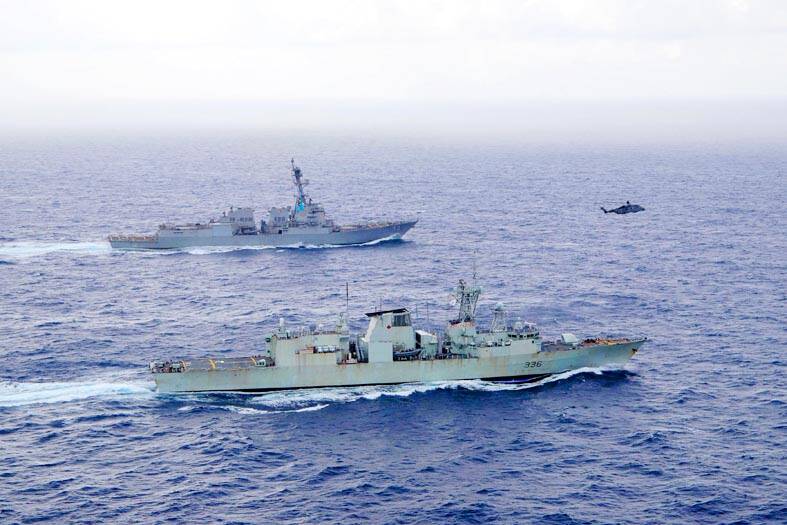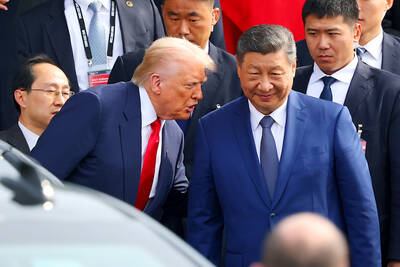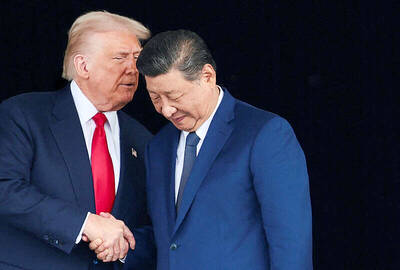A Canadian warship passed through the Taiwan Strait on Wednesday as part of what Ottawa called a commitment to an open Indo-Pacific region.
The Canadian Ministry of National Defense said the HMCS Montreal frigate had “recently conducted a routine transit” through the Strait.
The transit was a reaffirmation of Canada’s commitment to a “free, open and inclusive” Indo-Pacific region, Canadian Minister of National Defence Bill Blair said.

Photo: US Navy / Naval Air Crewman (Helicopter) 1st Class Dalton Cooper / Handout via Reuters
“As outlined in our Indo-Pacific Strategy, Canada is increasing the presence of the Royal Canadian Navy in the Indo-Pacific region,” Blair said, referring to Canada’s plan for the region announced in 2022.
Chinese People’s Liberation Army’s Eastern Theater Command spokesman Colonel Li Xi (李熹) said the passage of the Canadian frigate had “harassed and disrupted the situation, and undermined peace and stability across the Taiwan Strait.”
China’s troops were on high alert at all times and are “ready to respond to all threats and provocations,” he added.
China claims it has jurisdiction over the Taiwan Strait.
US warships, and occasionally US Navy patrol aircraft, pass through or over the Strait about once a month.
Canadian naval vessels are less common, though in November last year the US destroyer USS Rafael Peralta and a Royal Canadian Navy frigate HMCS Ottawa conducted a joint transit through the Strait.
In June, during another joint US-Canada drill in the strait, a Chinese warship came within 137m of a US destroyer in what the Pentagon called “an unsafe manner.”
The Ministry of National Defense (MND) in a statement yesterday said that the military had “full control” over the surrounding sea and airspace during the Canadian frigate’s transit from north to south through the Taiwan Strait, adding that it observed nothing unusual.
Separately, the military has been reporting near-daily sightings of Chinese warships around Taiwan’s waters, as well as sorties by drones and fighter jets around the nation.
The MND yesterday said 29 Chinese military aircraft and 10 naval vessels were detected in a 24-hour window ending at 6am.
Additional reporting by AFP

CALL FOR SUPPORT: President William Lai called on lawmakers across party lines to ensure the livelihood of Taiwanese and that national security is protected President William Lai (賴清德) yesterday called for bipartisan support for Taiwan’s investment in self-defense capabilities at the christening and launch of two coast guard vessels at CSBC Corp, Taiwan’s (台灣國際造船) shipyard in Kaohsiung. The Taipei (台北) is the fourth and final ship of the Chiayi-class offshore patrol vessels, and the Siraya (西拉雅) is the Coast Guard Administration’s (CGA) first-ever ocean patrol vessel, the government said. The Taipei is the fourth and final ship of the Chiayi-class offshore patrol vessels with a displacement of about 4,000 tonnes, Lai said. This ship class was ordered as a result of former president Tsai Ing-wen’s (蔡英文) 2018

UKRAINE, NVIDIA: The US leader said the subject of Russia’s war had come up ‘very strongly,’ while Jenson Huang was hoping that the conversation was good Chinese President Xi Jinping (習近平) and US President Donald Trump had differing takes following their meeting in Busan, South Korea, yesterday. Xi said that the two sides should complete follow-up work as soon as possible to deliver tangible results that would provide “peace of mind” to China, the US and the rest of the world, while Trump hailed the “great success” of the talks. The two discussed trade, including a deal to reduce tariffs slapped on China for its role in the fentanyl trade, as well as cooperation in ending the war in Ukraine, among other issues, but they did not mention

HOTEL HIRING: An official said that hoteliers could begin hiring migrant workers next year, but must adhere to a rule requiring a NT$2,000 salary hike for Taiwanese The government is to allow the hospitality industry to recruit mid-level migrant workers for housekeeping and three other lines of work after the Executive Yuan yesterday approved a proposal by the Ministry of Labor. A shortage of workers at hotels and accommodation facilities was discussed at a meeting of the legislature’s Transportation Committee. A 2023 survey conducted by the Tourism Administration found that Taiwan’s lodging industry was short of about 6,600 housekeeping and cleaning workers, the agency said in a report to the committee. The shortage of workers in the industry is being studied, the report said. Hotel and Lodging Division Deputy Director Cheng

‘SECRETS’: While saying China would not attack during his presidency, Donald Trump declined to say how Washington would respond if Beijing were to take military action US President Donald Trump said that China would not take military action against Taiwan while he is president, as the Chinese leaders “know the consequences.” Trump made the statement during an interview on CBS’ 60 Minutes program that aired on Sunday, a few days after his meeting with Chinese President Xi Jinping (習近平) in South Korea. “He [Xi] has openly said, and his people have openly said at meetings, ‘we would never do anything while President Trump is president,’ because they know the consequences,” Trump said in the interview. However, he repeatedly declined to say exactly how Washington would respond in